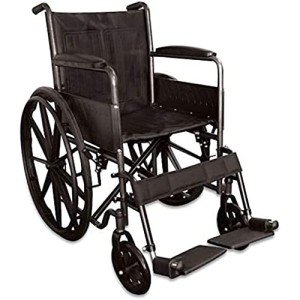Bariatric Wheelchair Seat Width
Seat Width
Having the appropriate seat width is very important to wheelchair users who spend longer durations in their chairs. Too narrow a seat will cause pressure on the hips and thighs which might result in sores or pressure points. Having too broad a seat can also make it difficult for the user to reach the hand rims to move themselves or maneuver in little areas.
To measure the correct seat width a person would sit on a chair normally and have their measurement taken across their lap at the largest point which is typically their hips. A wheelchair measuring tape can be used to measure this, but a yard stick is chosen as it prevents individuals from covering the tape around their hips which would give an inaccurate result.
The standard wheelchair seat width is 16" (narrow adult), 18" (standard grownup), and 20" (large grownup). For bariatric clients, a 24" seat is readily available. This sturdy additional wide bariatric wheelchair from Medline features swing-away footrests, a carbon steel frame with rust- and chip-resistant chrome plating, and easy-to-clean vinyl upholstery. It has a weight capacity of 500 pounds.
Seat Depth
Generally, the seat depth of a bariatric wheelchair was included 2" to the measurement taken at the user's widest point (generally their hips). This was implied to accommodate additional layers of clothes that may be used during cold weather. However, this practice is becoming less typical as wheelchair users are able to spend more time inside and are not wearing long coats. have a peek at these guys makes the seat depth of a chair less essential when selecting a bariatric wheelchair. However, bariatric wheelchair for sale near me is still crucial to select an alternative that offers sufficient assistance for bigger users.
The Medline folding additional broad bariatric manual wheelchair features a comfortable 24" seat width and a sturdy slide tube silver vein frame. It also has an adjustable axle and tool-free elevating legrests.
Seat Height
When it comes to determining the appropriate wheelchair seat width you ought to always measure from the user's best point which is usually their hips. You will likewise need to think about whether the user is going to be using a winter season coat as this might include 2" to the width required.
When a wheelchair remains in usage it should just be run on level surfaces with the wheel locks totally engaged. This is to avoid the chair from having the ability to move slopes that are 10 degrees or greater. It is also essential to bear in mind that any activity that may shift the center of gravity in the chair need to be made with care. This consists of reaching for products that require the individual to lean out of their seat or trying to stand up from it.
Whenever you have the chair in usage it is suggested that you routinely inspect it for damage and lubricate any locations that are considered necessary. For example, the casters must be lubricated by eliminating the caster fork and utilizing a multi-purpose grease to use to the caster stem bearings. Likewise, the foot plates can be changed by loosening up the bolt and then moving them to the preferred position. This allows the feet to sit easily on the footplate and prevents any pressure points from forming. This can be extremely uncomfortable for the user and if left unattended, can lead to pressure sores.
Weight Capacity
Bariatric wheelchairs are created to support more weight than standard wheelchairs. This makes them tougher and much better equipped to manage falls. They are likewise typically larger and larger, making them less maneuverable in tight spaces than basic wheelchairs. They need lorries with unique ramps and lifts to fill them, in addition to chauffeurs who know how to best transport them from one place to the next.

When picking a wheelchair, consider its weight capacity as it will be the primary determining consider whether it will accommodate your traveler's requirements. The weight capacity of the chair is typically listed as a fixed load, suggesting that it suggests the amount of weight the chair can easily hold while standing still. However, some makers likewise list an active load that is based on a drop test and can imitate the impact of somebody taking a seat in the chair. This might be a more dependable measurement of the weight limit, depending upon your requirements.
If you prepare to carry out activities that move your center of mass in the seat (such as reaching for things), make sure to have front casters pointed in a forward direction and wheel locks engaged so the chair will not topple. Likewise, inspect that casters are oiled regularly to prevent extreme wear and abrasions. The lubrication procedure involves removing the fork, separating the caster from the wheel, and greasing the caster stem bearings with high-quality multi-purpose grease.
